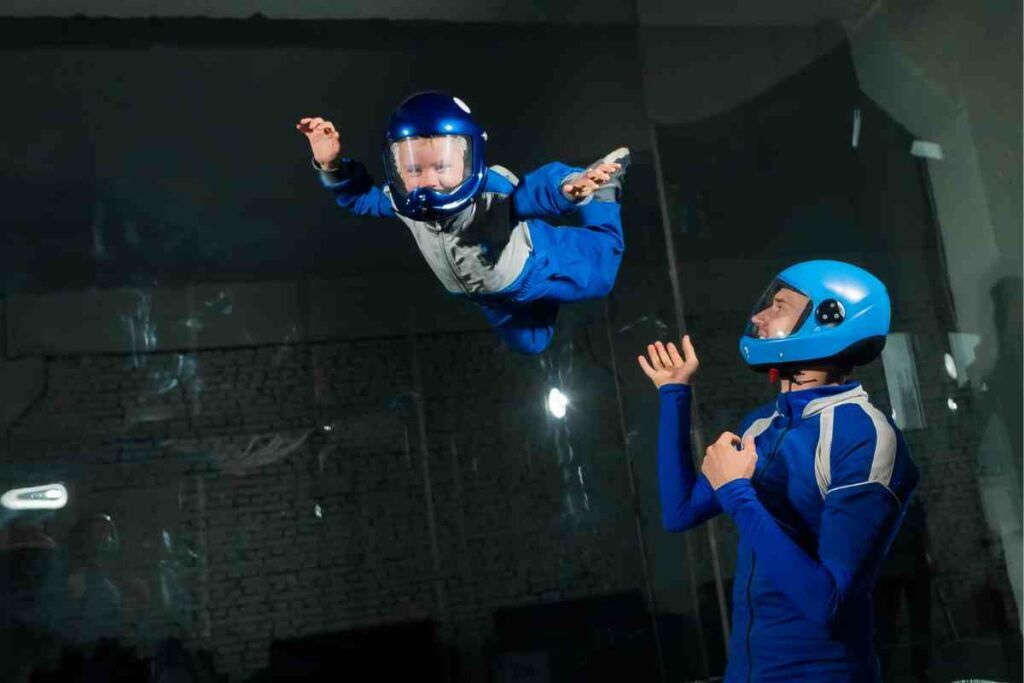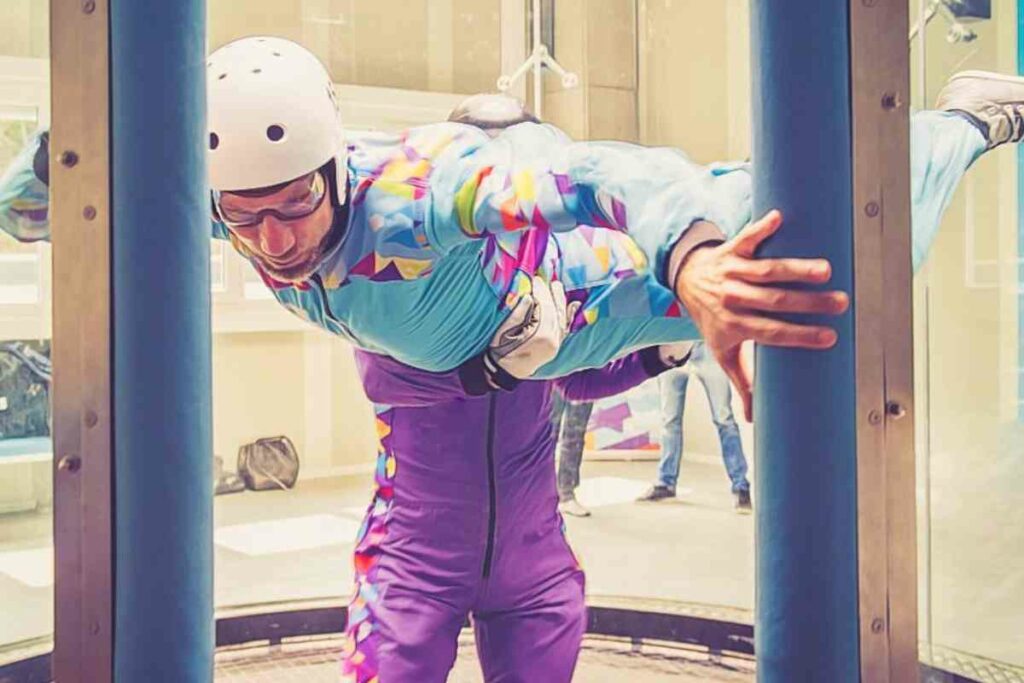Indoor skydiving expertly simulates the freefall feeling that you get skydiving for real!
How does the wind tunnel work during indoor skydiving?
The tunnel is made of super-thick walls of glass, inside of which, 450+ horsepower fans pull in and regulate air (which blows on you from below).
The result? An exhilarating freefall!
What to Expect?
When you’re skydiving outdoors, you fall at speeds of up to 120 MPH. To replicate this, it takes 450+ horsepower fans, perfectly regulated.

The wind tunnels are an impressive creation – who knew you could experience something as unique and exciting as skydiving, indoors, safe, and affordably? Thank the creation of the wind tunnel!
This wind tunnel typically blows about 125 – 170 MPH (200-275 km/h).
Beginners typically start on the lower end, while professionals and very experienced indoor skydivers reach as high as 170 mph (275 km/h). These fans are powerful!
Read before you go – Can You Indoor Skydive If You Have a Medical Condition?
How to Properly Use a Wind Tunnel
Replicating a skydiving freefall is no joke. It calls for super-strong winds, contained by ultra-strong glass.
Fortunately, everything is balanced so well that the environment is perfectly safe (except for the risk of a bump, which is unlikely with a helmet/proper gear).
Of course, you’ll need to dress properly so that you’re streamlined, and float as well as possible (as well as for optimum safety).
You’ll be provided with certain gear:
- Perhaps the most important piece of gear is the helmet. This will prevent head injuries… if you bonk your helmet into someone or something, you can just laugh it off.
- With powerful winds, it’s harder to see… the eyes tend to water. Thankfully, goggles will help keep your vision clear.
- It takes practice to learn how to straighten and curl your legs gracefully. In the meantime, you may accidentally kick, and that’s what knee pads are for. So you don’t accidentally bonk into the glass wall, or kick each other!
- Elbow pads are smart (and required) to ensure you don’t knock your elbows into each other!
- You will be given a flight suit to wear for the duration of your indoor skydiving experience. This will play a big role in streamlining you and ensuring that you float smoothly. Underneath, just make sure to wear comfortable, flexible clothing, so you can easily maneuver!
Along with the proper gear, you’ll need to meet certain requirements to enter the wind tunnel.
Pregnant women are not allowed to enter, as the powerful winds can cause too much movement, potentially resulting in placenta abruption. This can seriously put both mother and baby at risk.
Folks must also be 3+ in order to enter a wind tunnel!
Want to keep exploring? Continue your quest for knowledge and read our Complete Indoor Skydiving Beginners Guide!
Signals to Use in the Wind Tunnel
How do you communicate with your instructor when indoor skydiving?
Here are some basic hand signals, for the most important things you and your instructor need to say to each other:
- When indoor skydiving – and during any type of skydiving – form is key. This will make it much easier to maneuver and stay balanced and in control. To help you maintain your form, your instructor may let you know to put your legs out, by pointing two fingers straight together!
- If you need to talk to your instructor, or simply want to stop, you can do a thumbs down. This will let your instructor know you have some kind of a problem. They may approach you to verify that you want to stop, or to find out what the issue is and if there’s a quick fix!
- Your legs might be a little too straight and stiff, in which case, your instructor will show you two fingers curled up – pull your legs in. This should help you feel more balanced!
- If you’re looking down too much, your instructor may ask you to look up simply by pointing upwards. This will ensure they can see your face, and you can see well enough not to bump into other folk and generally maneuver.
- Finally, your instructor may give you a hang loose sign, which means that you should relax. This will help you float easier!
Final Words
So, wind tunnels work through the use of strong, thick glass and powerful fans. The fans are up to 450+ horsepower and create winds that are 125 – 170 MPH (200-275 km/h).
While it’s a well-controlled and fairly safe environment, it’s still key that you have the proper know-how and wear the necessary gear. You’ll also need to meet a few requirements in order to enter the powerful wind tunnel!







